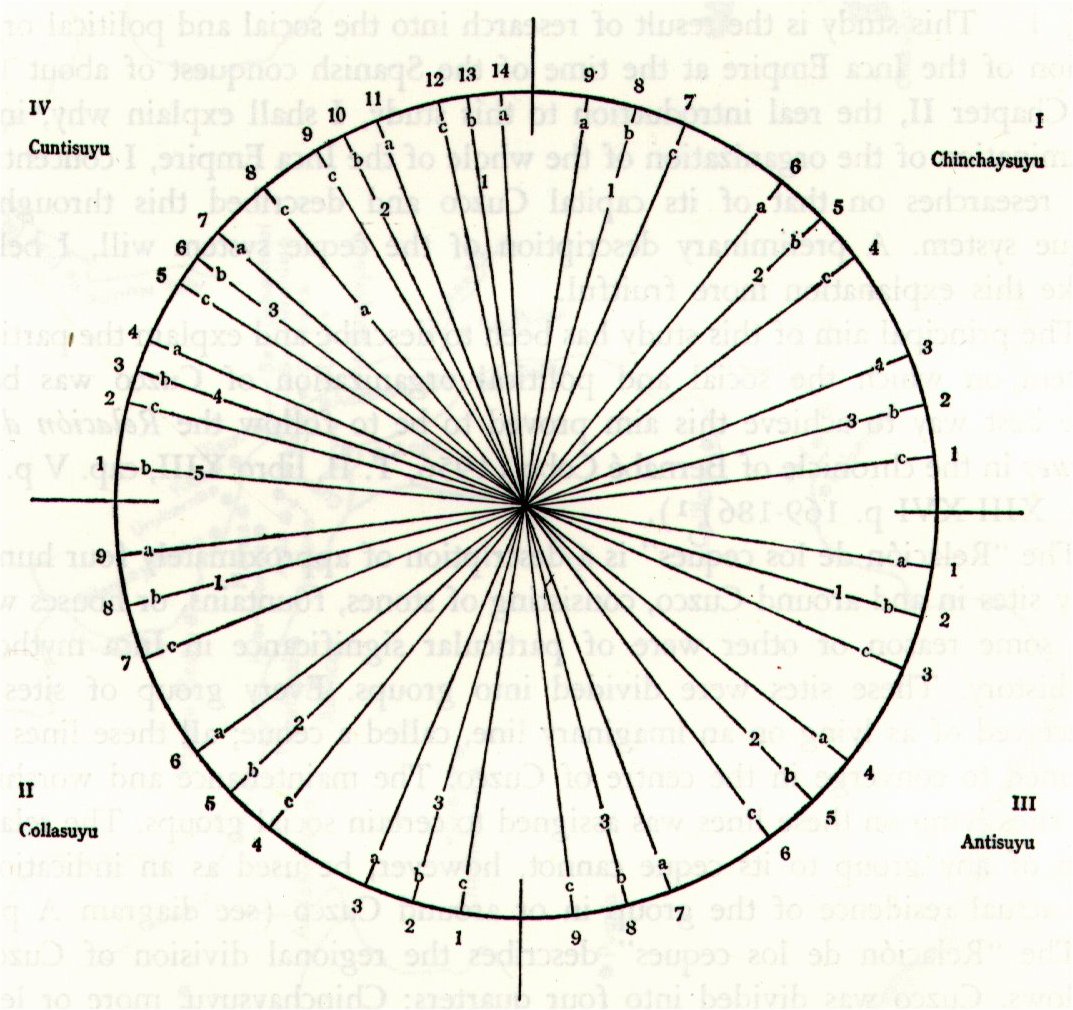|
TRANSLATIONS
The structure 3 + 4 = 7 for both summer and winter, establishing a greater 'fortnight' for the year, is symmetric and resembles the Inca ceque structures:
I and II (Chinchasuyu and Collansuyu) were 'white', while III and IV (Antisuyu and Cuntisuyu) were 'black'). Disregarding the Western Civilization 'black' means 'fertile' (like woman) in contrast to 'male' and 'white' (like dry old bones). Or - from another perspective - the 2nd and 4th quarters are full of life (and death), while the 1st and 3rd quarters are static. Or - from yet another perspective - the 2nd and 4th quarters are 'wet' (like moon), while the 1st and 3rd quarters are 'dry' (like sun). To repeat:
The hand gestures in Ka3-4 and Ka2-12 would then be alike because together the 4th 'quarter' (of winter) follows the 3rd 'quarter'. Yet, this type of hand gesture establishes a group of 3 * 2 = 6 bluemarked glyphs (Ka3-3--Ka2-14), leaving 5 * 2 = 10 redmarked glyphs (Ka2-15--Ka3-2) to another group. 5 + 3 'feathers' in haś (Ka3-11) could refer to these two glyph groups. 5 'feathers' are at the back (tu'a) - i.e. in the past - while 3 soon will arrive - implying the 3rd group of 8 glyphs could describe events between the end of the redmarked glyphs and the arrival of the blue glyphs:
Ka2-15 is fully grown and en face, presumably midsummer because of the hand gesture and the ordinal number. But in Ka2-16 only the spirit remains. Sun should not disappear at 16 but at 18. Therefore it must be the spirit of the moon. In Ka2-18 a similar glyph may describe the situation for the sun. We should notice the difference in the 'hand' - 'Y' could be used for the sun and another 'letter' for the moon. The 8 'feathers' in Ka3-11 suggest the moon (which according to the Mamari moon calendar has 8 periods). The cycle of the moon has a 'break point' at 16 (not at 15, the full moon night). With 28 nights with moon shining there must be a division into 2 groups, with 16 respectively 12 nights. It can be expressed as 4 + 3 (times 4). This agrees with the 3 + 5 = 8 feathers in Ka2-22, because the redmarked glyphs below (beginning with Ka3-1, the rising 'fish') establishes the growing moon phase (16 nights in 10 glyphs - maybe fetched from the number of months in a year):
This is getting quite complex. Is it at the same time both a map of the 28 nights of moon and the 364 nights of a year? The labels 4th 'quarter' etc refer to the two cycles of the year (summer and winter). I will not write of the sun because, astonishingly, there are no hetuu glyphs in K. Even if hetuu glyphs can be used for stars - other than the sun - they presumably would not be used in a calendar built around the moon. The stars are connected to the path of the sun by being in the background, but they are of no use in reading the phases of the moon. And, we remember, in K period 16 is special (while in the parallel text of G the special season continues up to and including period 18). And, we remember, in K there are 29 periods. We can also add that none of the manu rere in K has the typical hook of the bird of prey, which I suspect means the sun 'bird':
The moon 'bird' in e.g. Eb7-6 may be depicted in most of the K manu rere glyphs (in Ka3-17 for instance). The hand gesture connecting Ka3-3 and the following glyphs could be a moon equivalent of the 3 fingers towards mouth for 'eating' (growing) sun. The growing moon phase would then follow after the beginning at Ka3-1--2. The 'hook' at bottom left in Ka3-4 (a type of mauga without any sign of anything being swallowed) could be a sign of the growing moon crescent (south of the equator). There is one mauga in K with something inside, a 'ghostly' mauga shape with ordinal number 21:
We can, for the moment, disregard the year and try to illustrate the 8 periods in the cycle of the moon:
Period 8 will now be perceived clearly for what it is. The 3 periods of descending moon will be followed by 5 periods of growing moon. The 'fish-tail' hakaturou (in Ka2-21) serves to indicate the point of turnaround from one month to the next. The 'spectral' character in Ka2-22 illustrates the 29th night and the 16th night has a similarly 'spectre' in Ka2-16 (notice the ordinal number). In Ka3-3 the 'foot' is missing, leaving a 'spectre' sitting there. Maybe it is the old moon, who is a 'picture' (image, imago) for the new moon. After seeing this it is difficult to return to the cycle of the year again. But if it was only a kind of calendar for the moon, it would hardly begin with the 3rd period. Toki (top right) in Ka2-11 is presumably initiating the calendrical events, just as in Aa2-73 and Ab2-45:
Aa2-75 is glyph number 829 counted from Ab1-1. Ab2-45 is glyph number 127. 829 - 127 = 702 = 18 * 39. 1334 - 702 = 632 = 8 * 79, and we recognize the way to formulate: 18 * 39 with 8 and 9 at the end of the terms is balancing 8 * 79, also with 8 and 9. Though 39 = 3 * 13, while 79 is a prime number. Notice how the hand in Aa2-68 is resembling the special 'Y' in Ka2-16:
Also the 'kava hand' in Aa8-30 exhibits 1 + 2. And the strange sign at bottom may be an illustration of the ginger root:
|
|||||||||||||||||||||||||||||||||||||||||||||||||||||||||||||||||||||||||||||||||||||||||||||||||||||||||||||||||||||||||||||||||||||||||||||||||||||||||||||||||||||||||||||||||||||||||||||||||||||||||||||||||||||||||||||||||||||||||

































